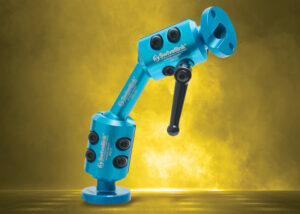By RMI, the Rack Manufacturers Institute
Pallet racks designed for use with automated solutions need to accommodate any specific automation requirements. Image courtesy of RMI.
As anyone who attended this past March can attest, warehouses, distribution centers, and fulfillment operations increasingly incorporate automated equipment. Many also utilize industrial steel storage rack within their facilities. Depending on the application, automation and pallet racks may interface as part of an operation’s current—or future—workflow. Therefore, to ensure a successful implementation, the members of the Rack Manufacturers Institute (RMI) offer design recommendations for operations integrating automation and pallet racks.
“More facilities are turning to automated solutions to address the ongoing shortage of available workers,” explained Jonathan Hirst, Vice President and General Manager of RMI member North American Storage Equipment. “However, to achieve the expected benefits such as higher productivity and accuracy, it’s important to first consider how automation and pallet racks will work together.”
Critically, pallet racks designed for use with automated solutions—including autonomous mobile robots (AMRs), automatic guided vehicles (AGVs), autonomous forklifts, or shuttle- and crane-based automated storage and retrieval systems (ASRS)—need to accommodate any specific automation requirements. Otherwise, the automated equipment may not function as expected.
That’s because automation requires extremely tight tolerances, explained John Schmidt, CEO of RMI member Rack Builders. “The navigation systems and optical sensors utilized by automation as it maneuvers around or within pallet racks need consistent, precise production tolerances on both beams and uprights,” he said.
If a rack is weak or overloaded, its structural members may bow, sag, or lean. Such conditions make it difficult for the sensors to detect and identify navigational waypoints. Inconsistencies in the rack structure can also impede the automation’s ability to properly and accurately place or remove loads within it. It can also make it exceedingly difficult to integrate racks with different types of goods-to-person automation that require precise design parameters to work as planned.
Key Considerations for Implementing Automation and Pallet Racks

Choosing R-Mark certified racks will ensure that they have passed a stringent review process and meet RMI’s published ANSI standards. Image courtesy of RMI.
When thinking about utilizing automation and pallet racks, RMI recommends considering the following factors:
Product and Load Characteristics – This includes dimensional information about the products and loads handled and stored. Account for product size, shape, weight, quantity, and storage medium—such as a tote, a cardboard case carton, or a unitized pallet load.
Inbound Receiving and Outbound Shipping Processes – Determine how each product enters the facility, as well as how it is stored, selected, picked, packed, and shipped. “Products that arrive in unitized pallets by the truck load, but ship out as individual items, require a different configuration of automation and pallet racks than products that are transferred one pallet at a time from a manufacturing process into storage,” said Schmidt.
Inventory Accessibility Needs – Some stored items are in higher demand than others. That is, certain products require high selectivity pallet rack configurations. Others that have lower pick frequencies are ideal for higher density—but less accessible—storage rack systems. “Selectivity and density are inversely proportional; as density increases, selectivity decreases,” Schmidt added. “This can impact both the selection of automation and pallet rack design.”
Storage System Lifespan – When calculating the total cost of ownership of both automation and pallet racks, factor more than just the initial price of the system. The calculation should also include anticipated productivity gains, system durability, routine maintenance, and repairs over the entire lifespan of the solution. “The quality of the racking system installed can make an enormous difference to the bottom line,” Schmidt said.
Change Management Efforts Enhance Automation Acceptance
The most successful automation deployments prioritize associate involvement at the outset of the project, noted Arthur Fendel, Vice President of Sales and Engineering at STOW. The company is a member of both RMI and the Automated Storage and Retrieval Systems (ASRS) industry groups.
“To ensure that associates utilize the automation correctly and safely, it’s important to make them aware of the benefits of the system, communicate process changes, and start training as early as possible,” Fendel explained. “Operations that wait until the automated system is up and running before introducing it to associates are more likely to experience resistance to, or misuse of, the solution.”
Sometimes front-line warehouse associates aren’t the only ones reluctant to accept automation, he added. “When integrating automation and pallet racking it can be challenging to get buy-in for the new solution throughout the organization. It’s very important to communicate the benefits of the new technology not only for the operation, but also for the entire company.”
R-Mark® Certified Rack Manufacturers Deliver High Quality Rack
Operations that are unsure about the ability of their existing or new pallet racking to meet the critical quality standards required by automated equipment can look for R-Mark certified manufacturers. Created by RMI, this voluntary program applies to manufacturers, their individual systems, and unique system installations.
To attain an R-Mark Certification, rack manufacturers—whether members of RMI or not—must pass a stringent review process conducted by an independent, professional rack engineer. The assessment verifies that the manufacturer designs and builds rack systems that meet RMI’s published American National Standards Institute (ANSI) standards. These include:
- ANSI MH16.1: Design, Testing, and Utilization of Industrial Steel Storage Racks, referenced by the International Building Code (IBC) as the standard for safe design and installation of steel storage racks
- ANSI MH16.3: Design, Testing, and Utilization of Industrial Steel Cantilevered Storage Racks
- ANSI MH26.2: Design, Testing, and Utilization of Industrial Steel Rack Decking
The standards establish requirements for the safe design, engineering, testing, installation, and inspection of storage rack and decking, added Hirst. “R-Mark Certification is essentially a seal of approval from RMI that a manufacturer upholds the highest quality and safety standards of the industry.”
Learn More About Automation and Pallet Racks from RMI Members
RMI members are the industry’s leading suppliers of industrial steel storage racks and related structural systems. They supply industrial rack solutions worldwide and in virtually every major manufacturing and distribution sector.
For more information about integrating automation and pallet rack, RMI members are available for consultations, insights, and recommendations. The RMI and ASRS industry groups also recently hosted an online Tech Talk and an educational seminar at MODEX 2024 on this topic. Visit mhi.org/rmi for additional details.
The post Integrating Automation and Pallet Racks? Follow These Design Recommendations For A Successful Implementation appeared first on Workplace Material Handling & Safety.





